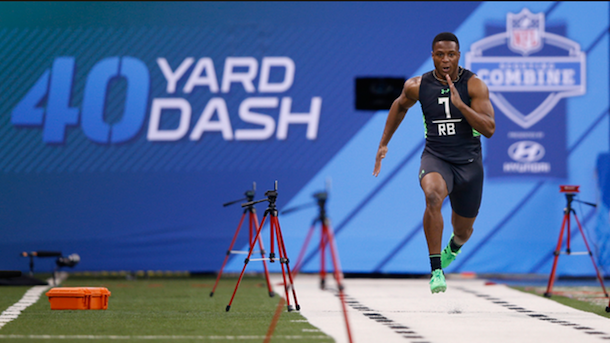
Arguably no man has made more significant contributions to the evolution of the game of football than Paul Brown. The great Browns coach during their most successful period, Brown later founded and coached the Bengals – whose stadium still bears his name. He was the first coach to use game film to scout opponents, hire a full-time staff of assistants, and test players on their knowledge of a playbook. He invented the modern face mask, the practice squad, and the draw play. He also played a significant role in breaking professional football’s color barrier.
Of the many contributions Brown made to the sport, he never could have imagined that a speed test he invented would be such a significant piece of evaluating potential NFL players. From Michael MacCambridge’s America’s Game: The Epic Story of How Pro Football Captured a Nation:
Intent on building a fast team, [Brown in the mid-1940s] began timing players in the 40-yard dash, rather than the 100, reasoning that the 40 was a more meaningful measure of true football speed, about the distance a player would cover on a punt.
From its origins of how quickly can you cover a punt, the 40-yard dash now gets the most hype during combines and pro days. The question most often asked by players at a combine – at any level – is “what did you run?” Seems it’s evolved to the point now that grading out higher than your competition in the test of sprinting goes farther than any other test in determining your skill on a football field. So, do 40-yard dash times really matter?
Sure they do. There are specific athletic traits that can be tested as a way to determine what skills translate from high school to the college game, and from college to the pros. For example, if you test much slower in the 40 at a combine than what your game tape might suggest, that’s cause for concern; especially in the pros, where the game is quicker and faster than it is in college. But, for every Champ Bailey (1999 Scouting Combine: 4.28) there’s a Fabian Washington (2005: 4.29). For every Rod Woodson (1987: 4.31) there are many players who can run fast in a straight line but are not football players.
In short, all of these combine tests are geared toward grading players’ athletic ability: 40, 3-cone, broad jump, etc. Together they don’t particularly show who could actually play football, but they provide enough information to build an athletic profile and that information is designed to show who can’t play.
That’s an important distinction to make the next time you get ready to run a 40. Running 40 yards without pads is good – there’s a reason it’s stuck around for so long after Paul Brown’s invention – but playing fast with pads on is what makes a football player. And that takes a lot more than running in a straight line.
I don’t think the title of your article matches the content lol. Just kidding, mainly because I had some doubts after reading the article.
Your article helped me a lot, is there any more related content? Thanks! https://www.binance.com/it/register?ref=S5H7X3LP
Thanks for sharing. I read many of your blog posts, cool, your blog is very good. https://www.binance.com/ru/register?ref=UM6SMJM3
Your point of view caught my eye and was very interesting. Thanks. I have a question for you.
Thanks for sharing. I read many of your blog posts, cool, your blog is very good.